By Contributing Editor Cynthia Houng
In Rome, Gian Lorenzo Bernini (1598-1680) is nearly unavoidable. Walk down the center of the Piazza S. Pietro and look up. All along the great curving wings of the Piazza’s colonnades stand Bernini’s saints–carved and executed by other sculptors, but envisioned by Bernini. There he is in Piazza Navona, with the Fontana dei Fiumi, or Fountain of the Four Rivers. Those are his angels on the Ponte Sant’Angelo. That playful little elephant bearing an obelisk in front of Santa Maria sopra Minerva? That belongs to him, too. Only by leaving the historic city center can one escape him. Much like Michelangelo, another sculptor turned architect and impresario, Bernini transformed himself from a maker of precious objects to a maestro whose vision re-shaped the city. If Bernini is synonymous with the Baroque, it is due to his success working on this grand scale, shaping and molding the fabric of Rome to suit the dreams and needs of the Church and its princes.
* * *
In the fall of 2017, a monographic exhibition on Bernini opened at the Galleria Borghese, curated by Anna Coliva (also director of the Borghese) and Andrea Bacchi (director of the Fondazione Federico Zeri in Bologna). By the curators’ own admission, there has been no shortage of Bernini-related exhibitions in the past decade. So why mount another one? Their rationale is deceptively simple: “We have attempted for the first time to cover Bernini’s whole career,” with the exception, of course, of those site-specific works (fountains, altars, the baldachin in St. Peter’s) that cannot be moved. What this means, in reality, is that the curators have collected an extraordinary range of freestanding works by Bernini and his workshop. The exhibition also includes Bernini’s paintings (seldom exhibited en masse), sculptures by Bernini’s father, Pietro, and preparatory works for monumental commissions like the Four Rivers Fountain.
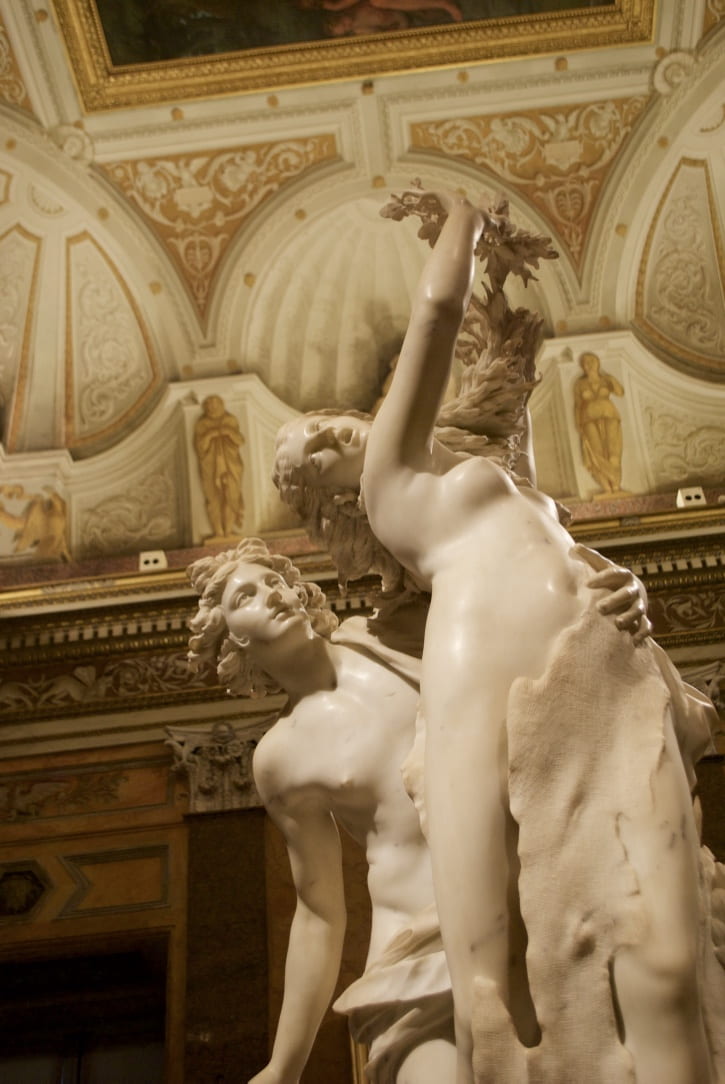
Gian Lorenzo Bernini, Apollo and Daphne, Galleria Borghese. All photographs by Cynthia Houng
So much has been written on Bernini in recent years that it seems impossible to propose anything new. But the experience of encountering Bernini’s work is always new. Each encounter is a dance, a performance that requires the beholder’s participation. There are no passive audiences here. Bernini’s orchestration of the pilgrim’s approach to St. Peter’s exemplifies the performative, relational nature of his work. As a series of impressions leading the pilgrim out of the quotidian world and into another world altogether, the work is, to use the language of another time, site specific and performative, requiring activation by a participant in order to be complete. The power of the encounter, and the effect of the performance on the participant-beholder–Bernini’s partner, really, in the work–is ecstatic. In Rudolf Wittkower’s evocative description, the performance of approaching St. Peter’s cathedral via the Piazza transports the viewer “beyond the narrow limits of his own existence and be entranced with the causality of an enchanted world.” In St. Peter’s, “the beholder finds himself in a world which he shares with saints and angels, and he is therefore submitted to an extraordinarily powerful experience. A mystery has been given visual shape, and its comprehension rests on an act of emotional participation rather than one of rational interpretation.”
“The challenge that Bernini set himself in his religious architecture,” Fabio Barry argued, “was always to create visions whose credibility depended upon them being experientially fleeting but permanent in the mind. God had created a heaven, but because its unveiling at the end of time was eternally distant yet perpetually imminent, Bernini must create a heaven just for us.” And who wouldn’t want to experience heaven again and again, each time anew? And so both scholars and laypersons find themselves drawn back to Bernini, each return an attempt to parse their own experiences of Bernini’s art.
The Borghese show makes full use of the relational, performative aspects of Bernini’s work. It is an object-oriented show in the fullest sense, all of its arguments and propositions originate in the objects gathered for the exhibition, in the relationships formed between them, and in the possibilities of close observation and comparison. It invites the visitor to participate in a hermeneutics of looking.
The show is both ambitious and ravishing. It makes full use of the Villa Borghese’s fabulous setting, occupying both the ground floor galleries (where Bernini’s Apollo and Daphne has resided since its creation), and the smaller, more intimate rooms on the second floor. The Metropolitan Museum of Art’s 2012 exhibition, “Bernini: Sculpting in Clay,” was a marvel, but the show was installed in the antiseptic Lehman wing. The Met did not have the benefit of the Borghese’s setting, with its sumptuous ornamentation and rich installations of Old Master paintings and Classical sculptures. Though the Borghese was largely redone in the eighteenth century (by the architect Antonio Asprucci, under the patronage of Prince Marcantonio Borghese IV), it had always served as a site for the display of art. These eighteenth-century renovations codified the building’s role as a site for the display of art. In her study of Asprucci’s renovation of the Galleria Borghese, Carole Paul noted that “Asprucci coordinated the decoration of each room to form a sumptuous ensemble unified in form and content, including the statuary.” Asprucci took everything–from the marble floors to the carved cornices–into consideration, creating new juxtapositions between the paintings, sculptures, and their environments. He also shifted Bernini’s statues, David (1623) and Apollo and Daphne (1622-25), from their original seventeenth-century locations. Today, neither sculpture can be viewed as Bernini intended. Though one can no longer see Bernini’s sculptures in their seventeenth-century settings, the richness and intensity of the Borghese’s environment is closer to how these works were meant to be seen than the clean, white galleries of the modern museum. More importantly, the placement of Bernini’s sculptures in the Borghese maintains their connection to the painting of his time, a connection that is particularly important to the argument of the Borghese’s “Bernini” show, which dedicated an entire section to Bernini’s own practice of painting.
Due to its constraints, “Bernini” is more heavily weighted towards the artist’s production for private patrons. However, Bernini’s greatest patron was the Church. As Wittkower noted in his 1955 study of Bernini (the first English-language study of Bernini intended for a broad audience): “it was Bernini’s tremendous achievement in the area of the Vatican that secured his reputation as the first artist of Europe.”
Appropriately, for our secular age, the major patrons of the Bernini exhibition at Villa Borghese were a bank and a fashion house–Intesa Sanpaolo and Fendi. And this is no accident. If, in Bernini’s time, the Church was the greatest orchestrator of spectacle, then commerce must be the Church’s contemporary analogue. We have grown comfortable with the imbrication of aesthetics and capital. We have even come to expect it. When I saw that Fendi sponsored the Borghese’s Bernini show, my first reaction was, “Of course.” Fendi has been funding various cultural initiatives around Rome, where the house has its headquarters, as part of the house’s mandate to invest in the city’s cultural capital. (Fendi also sponsored the restoration of the Trevi Fountain.) My second reaction was to note the exceptionally spectacular quality of the exhibition’s presentation–the display cases, the lighting, the installations, the quality of the fixtures–which matched the quality and finish of those intended for luxury boutiques.
* * *
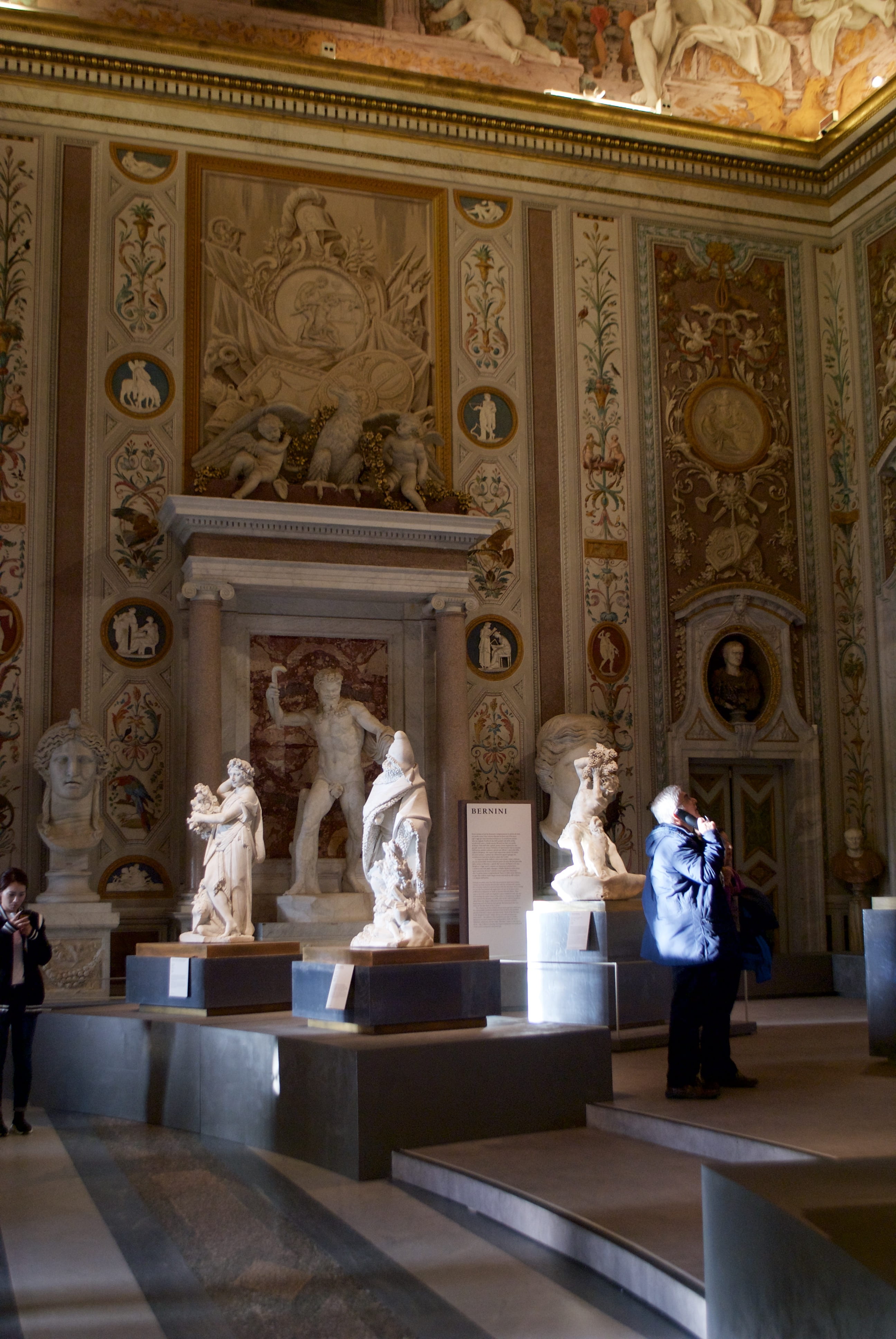
Installation View, Sculptures by Gian Lorenzo and Pietro Bernini, Galleria Borghese
The Borghese’s “Bernini” exhibition presents a narrative weighted towards the earlier stages of Bernini’s long career. This emphasis was dictated, in part, by the show’s constraints: it could rely only on freestanding, movable works to make its arguments, and much of Bernini’s later output can be characterized as site-specific installation work, literally inseparable from its architectural setting. (The Cornaro Chapel is not going anywhere.) Walking through the show, visitors witness how Bernini became Bernini. The show presents some of his earliest works–including collaborations with his father, Pietro as well as early independent works. Pietro Bernini’s sculptures are also part of the Borghese presentation, and through the younger Bernini’s sculptures we witness Gian Lorenzo’s talent unfurling.

Model for the Four Rivers Fountain, Galleria Borghese
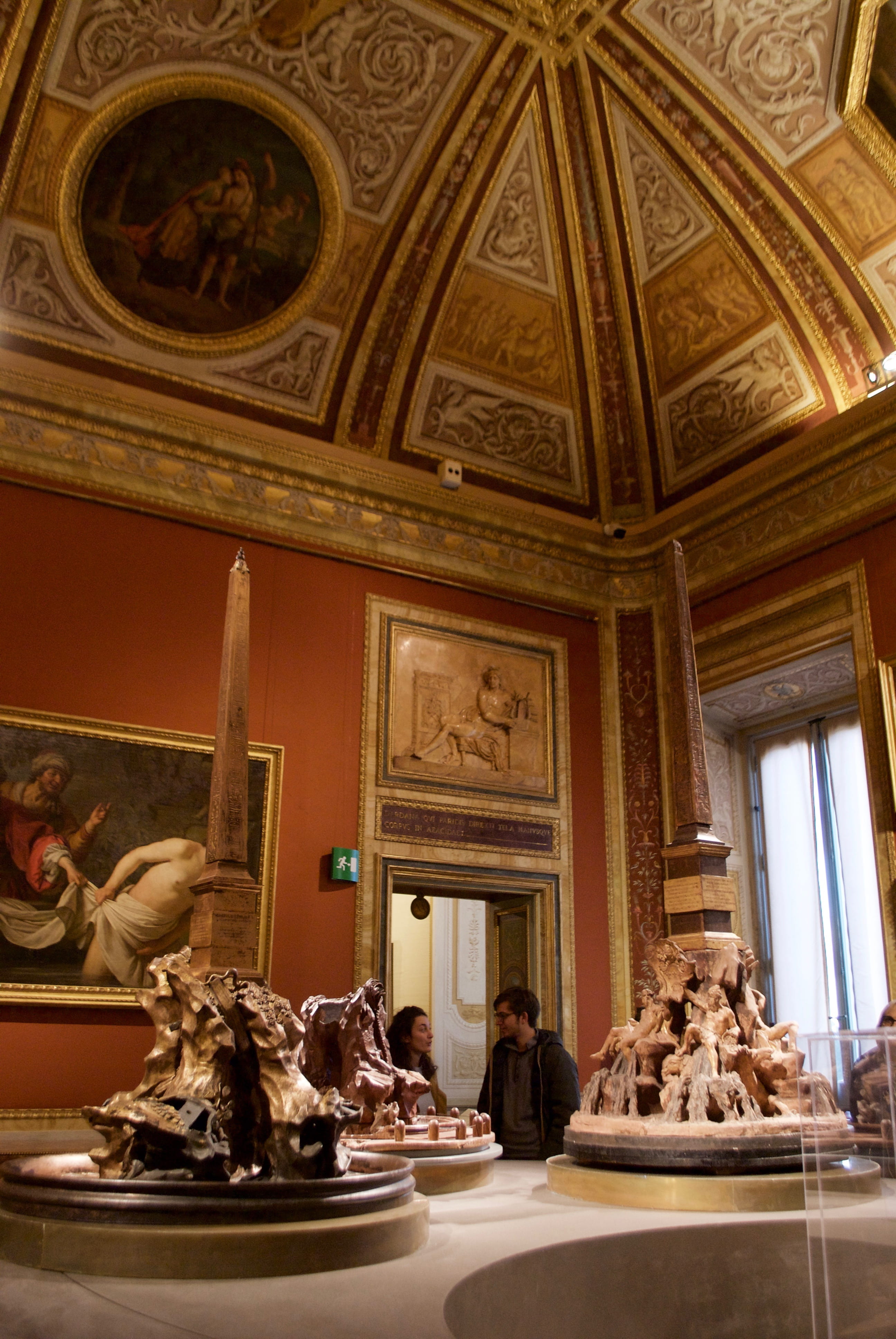
Installation view of bozzetti and modelli, Galleria Borghese
More interesting–and startling–is the development of Bernini’s aesthetic, the emergence of a strong and powerful stylistic vision, though again the show references Bernini’s mature works largely through proxies–through sketches and models for large-scale projects such as the Four Rivers Fountain, Cathedra Petri, and Ponte Sant’Angelo. And for almost all of Bernini’s works–even the bozzetti and modelli–there is always the question of authorship, of hands and facture. (The Met show addressed this problem of the “hands” in remarkable, technical detail.) The Borghese show is less interested in these questions. The curators take it as givens that Bernini operated a large workshop, and that he often outsourced work to other sculptors. As Bacchi and Colivo note in the introductory essay, the show aimed for “a direct dialogue with the works,” and many of the objects are on display together for the first time. The two monumental crucifixes have never been gathered in the same space before.
The show also invites viewers to consider different facets of Bernini’s practice in relation to each other. At the Borghese, visitors can view Bernini’s early putti in relation to his classically-inspired sculpture, The Goat Amalthea (an early work dated before 1615, probably made when Bernini was about 16), in relation to his restoration of ancient Roman sculptures–such as his restoration work on the famous Hermaphrodite sculpture, and to the angels and putti that he imagined for the Ponte Sant’Angelo and the Baldachin and Cathedra Petri projects in St. Peter’s cathedral.
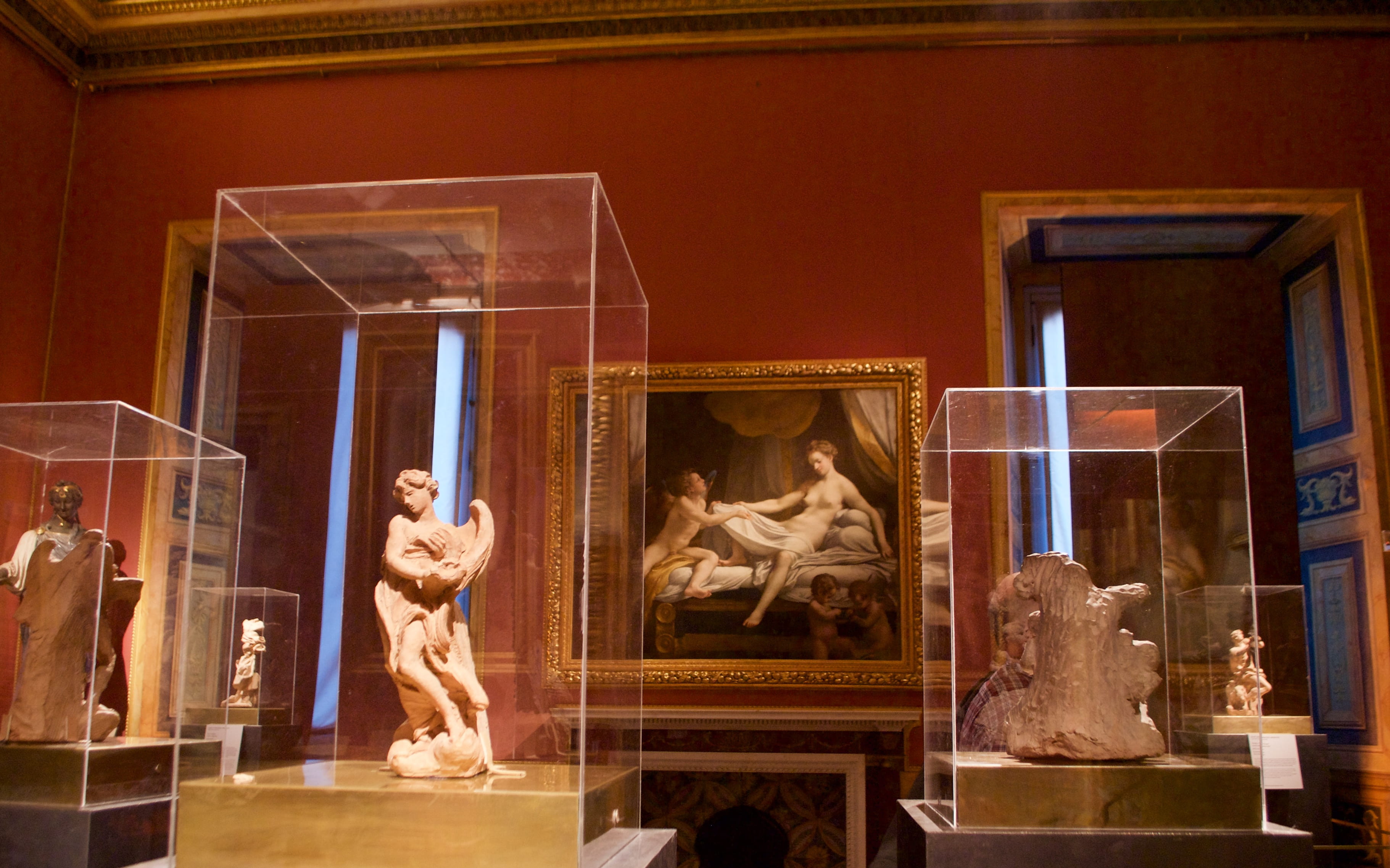
A room full of bozzetti, Galleria Borghese
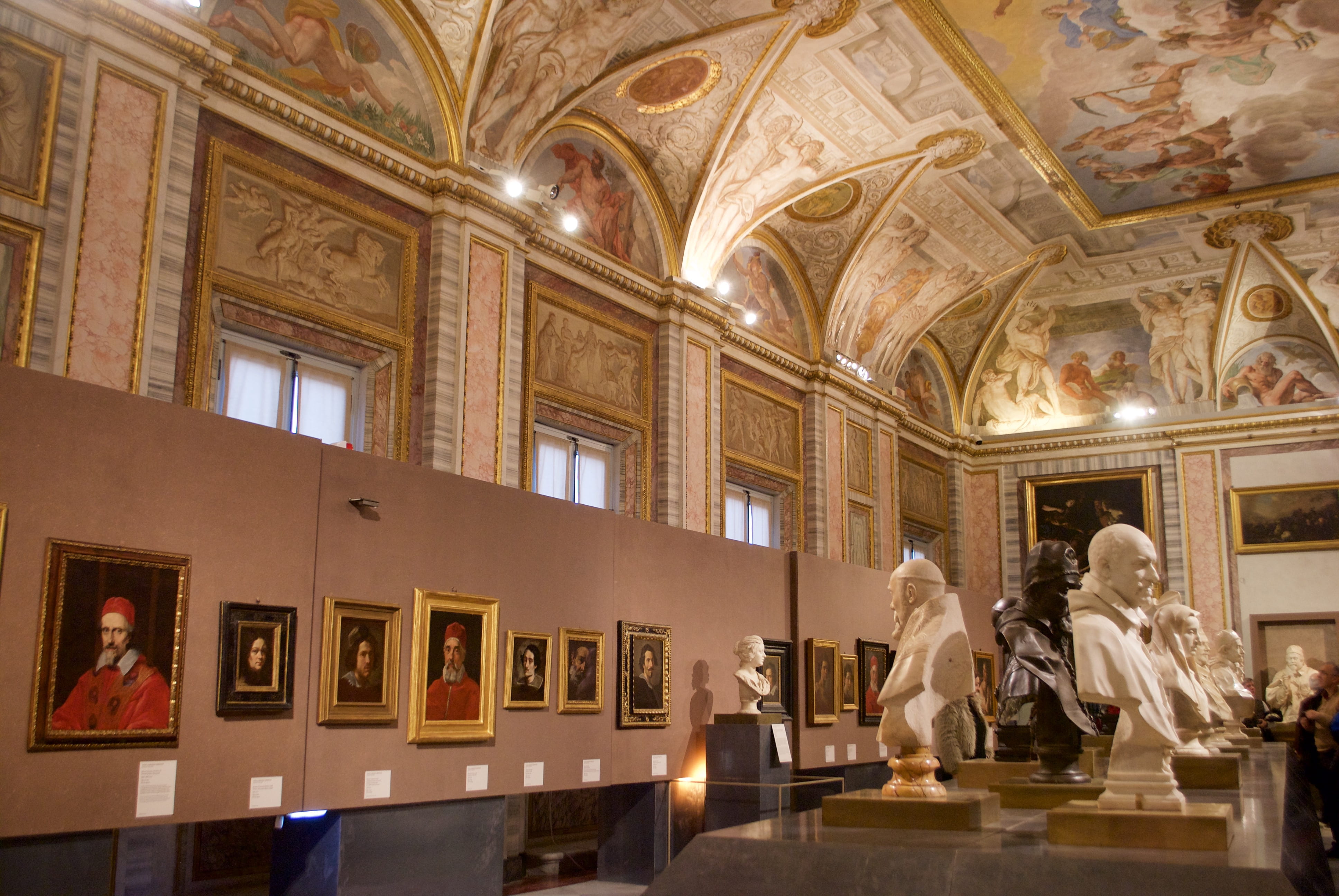
Installation View, Portrait busts and paintings, Galleria Borghese
The portrait busts and paintings, displayed together in one long gallery, form an interesting dialogue. Bernini is not often thought of as a painter. The paintings gathered for this exhibition will probably not elevate him to the pantheon of great painters, but they are very interesting as windows into his creative practice. They also provide us with clues to his relationship with the painting of his time. And the Borghese, with its impressive collection of Old Master paintings–though several of the Borghese’s most important Caravaggio paintings were on loan to the Getty during this show–provided an apt location to think about Bernini’s style and aesthetic in relation to the painting of his time.
Tightly focused on Bernini, this show was both an investigation and a celebration. It is a testament to Bernini’s magnetism as a subject that the wider world seems to pull in and collapse around him. The Roman Baroque narrows down to the Age of Bernini. The show is both spectacular and ravishing, and it reminds us of how far we can go–how much we can do–with an intense focus on the works themselves. It is their world that we wish to enter. And once there, we linger in pleasure.
At the same time, the Borghese show does not present the full breadth of Bernini, the man, or Bernini, the artist. It is a highly specific vision, one that presents him as a great genius, on par with the other “giants” of Italian sculpture named by the show’s curators in their introduction: Donatello, Michelangelo, Canova. Bernini had another side, one not revealed in this show. As Alexander Nagel once pointed out, “Just about everyone who knew him hated him.” He was domineering, violent, and ruthless. He slashed his mistress’s face in anger. One didn’t have to have to know Bernini to loathe him. In his biography of Bernini, Franco Mormando quotes anonymous pasquinades directed at Bernini, critiques affixed by unhappy Romans to the statue of Pasquino in the Piazza di Parione. The expensive transformation of the Piazza Navona by the Pamphilj family–which included the construction of Bernini’s spectacular Four Rivers Fountain (completed in 1651)–elicited such pasquinades as “Dic ut lapides isti panes fiant [Turn these stones into bread]!” Ordinary Romans, tired of poverty and hunger, railed against the Church’s immense expenditures on projects that did not benefit the populace.
Mormando quotes an impressive kaleidoscope of criticisms, describing Bernini as selfish and avaricious, and accusing him of robbing the papal treasury to enrich himself. Mormando cites an avviso from August 30, 1670, blasting Bernini as “the one who instigates popes into useless expenditures in these calamitous times.” By this time, Bernini was a wealthy man. (Pietro da Cortona was one of his few contemporaries who achieved comparable levels of wealth, and Cortona was, by all measures, also not a very nice man.) The construction of the Piazza San Pietro, with its colonnades and statues, cost 1 million scudi, roughly half of the Church’s yearly revenue. For Bernini’s critics, whether or not ordinary Romans enjoyed the aesthetic experiences of encountering the Four Rivers Fountain or progressing through the Piazza San Pietro was beside the point. Aesthetic pleasure provided no relief from poverty: “We don’t want obelisks and fountains; it’s bread we want!”
* * *
In 2017, Fendi initiated a three-year partnership with the Galleria Borghese, providing support for the establishment of a Caravaggio Research Institute. This description of the partnership between Fendi and the Borghese comes from the press release for the “Caravaggio” exhibition at the Getty Museum: “The partnership between the Galleria Borghese and FENDI is part of a patronage begun by the luxury goods House in 2015, and is based on the company’s belief that beauty must be shared and spread, and that the incomparable richness of the Galleria Borghese, a reflection of the Eternal City, is a powerful, cosmopolitan pathway to promote a refined cultural sensitivity, both contemporary and universal, in the same way that FENDI pursues in its collections a true example of aesthetic research and the absolute sign of ‘Made in Italy.’”
In our time, commerce has replaced the church as art’s great patron. Private sponsorship of public patrimony raises difficult questions–of appropriation, commodification, profit, and control. It pulls the public patrimony into a process where values inherent in the cultural ‘patrimony’ or ‘heritage’–sometimes called ‘heritage values’–are captured, accumulated, and commodified by private entities. The process is widespread enough to merit its own neologism,“heritagization.” And it is almost always twinned with commodification. Salvatore Settis has written and lectured extensively–and passionately–on this subject, arguing that the transformation of cities rich in cultural heritage–such as Venice and Rome–is almost always accompanied by ossification and decline, as the city ceases to be a city for the living and transforms into a museum city, a set piece for the delectation and consumption of tourists. And yet the profits from the heritagization process flow, not to the public, but to the private entities who sponsored–capitalized, really–the process. As Pablo Alonso Gonzalez noted in his study of the heritagization process in Maragateria, Spain, the process can alienate the community from its heritage or patrimony, eliciting resistance and even fury from community members.
The relationship of the past to the present is always tricky, but perhaps exceptionally so in a place like Italy, where the past is all pervasive, where there is so much value to be extracted from the past (via industries like tourism), and where the past weighs heavily upon the present. History can feel, at times, like a straitjacket upon the present, as the city ossifies into an open-air museum. There is the Rome for the past–but where is the Rome for the living?
Fendi is not the only Italian luxury house to invest in Italy’s cultural heritage, in order to capture and accumulate “heritage values.” Tod’s sponsored the restoration of the Colosseum. Bulgari chose to restore the Spanish Steps. Telecom Italia (also known as TIM) is sponsoring the “re-launch” (the verb employed in the press release announcing the project) of the Augustus Mausoleum through its Fondazione TIM. But investment in Italian cultural heritage is not limited to Italian entities. In a 2014 interview with the New York Times, the minister of culture, Dario Franceschini, said, “Our doors are wide open for all the philanthropists and donors who want to tie their name to an Italian monument. We have a long list, as our heritage offers endless options, from small countryside churches to the Colosseum. Just pick.”
Sponsorship isn’t the only mode of privatization. In a 2007 article, Roland Benedikter noted that a set of laws, introduced in 2002, allowed the Italian government to sell objects and monuments “to international investment firms and private investors for amounts that many Italian experts consider well below the median market price.” Benedikter noted that, since 2002, the privatization of Italian cultural heritage has been “the subject of heated public debate [for it] concerns the limits of privatisation, and could lead to a broad new anti‐capitalism movement.” Settis, too, frames his argument in terms of opposition not only to commodification but also to neoliberalism.
One might argue that Bernini would have understood this process–that, perhaps, he would have encouraged and embraced it. After all, only a hair’s breadth separates the tourist from the pilgrim, and Rome made a mint off pilgrims. (Rome continues to make a mint off pilgrims. The 2000 Jubilee drew 35 million visitors to Rome.) But one might also argue that we live in different times, with different ethics and ideals–and the society we wish to live in looks nothing like the one Bernini knew.
Our wishes, though, are not always consonant with our realities. Neoliberalism, globalization, and capitalism have all incited resistance and fury from the people of Rome. I am no expert on the intricacies of Roman or Italian politics, but it would not be an exaggeration to say, given the recent elections, that Italy is in a difficult place. And– Bernini would also have been familiar with this–the fury of the people is neither predictable nor easily channeled. We don’t want obelisks and fountains; it’s bread we want.
Or perhaps more pointedly: We don’t want to live among the patrimony of the past. Nor do we want to alienate our heritage to enrich certain select private coffers (does this sound familiar, again?). We want to be able to create a patrimony that we can call our own.
Bernini was on view at the Galleria Borghese in Rome from Nov. 1, 2017 – Feb. 4, 2018. The exhibition was accompanied by a catalogue (available in Italian or English).



3 Pingbacks